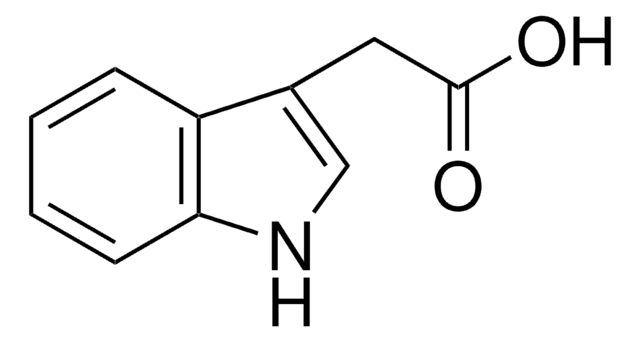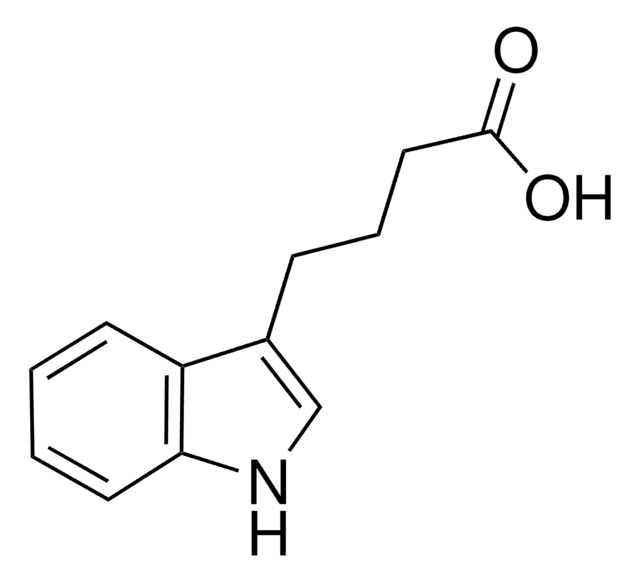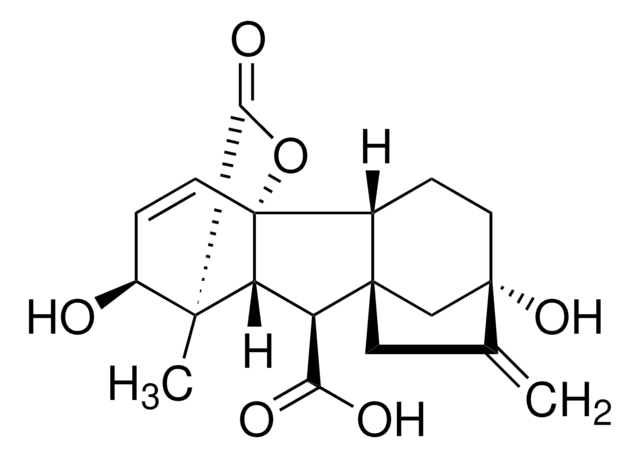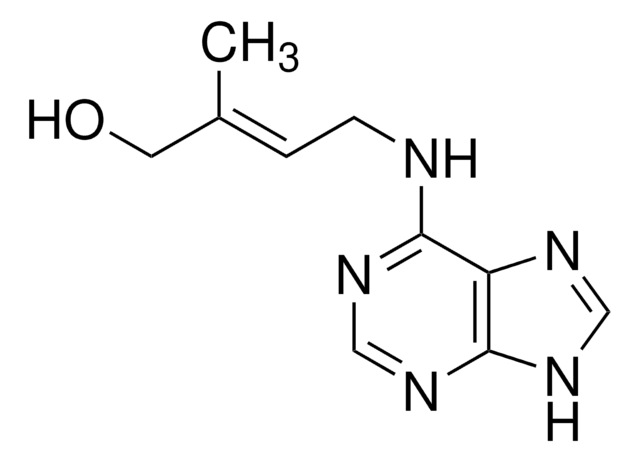I5386
Indole-3-butyric acid
suitable for plant cell culture, BioReagent
동의어(들):
4-(3-Indolyl)butanoic acid, 4-(3-Indolyl)butyric acid, IBA
로그인조직 및 계약 가격 보기
모든 사진(4)
About This Item
실험식(Hill 표기법):
C12H13NO2
CAS Number:
Molecular Weight:
203.24
Beilstein:
171120
EC Number:
MDL number:
UNSPSC 코드:
10171502
PubChem Substance ID:
NACRES:
NA.72
추천 제품
제품 라인
BioReagent
분석
≥98% (TLC)
양식
solid
기술
cell culture | plant: suitable
응용 분야
agriculture
저장 온도
2-8°C
SMILES string
OC(=O)CCCc1c[nH]c2ccccc12
InChI
1S/C12H13NO2/c14-12(15)7-3-4-9-8-13-11-6-2-1-5-10(9)11/h1-2,5-6,8,13H,3-4,7H2,(H,14,15)
InChI key
JTEDVYBZBROSJT-UHFFFAOYSA-N
유사한 제품을 찾으십니까? 방문 제품 비교 안내
애플리케이션
Indole-3-butyric acid (IBA) is auxin-family plant hormone (phytohormone). IBA is thought to be a precursor of indole-3-acetic acid (IAA) the most abundant and the basic auxin natively occurring and functioning in plants. IAA generates the majority of auxin effects in intact plants, and is the most potent native auxin.
제조 메모
관련 제품
제품 번호
설명
가격
신호어
Danger
유해 및 위험 성명서
Hazard Classifications
Acute Tox. 3 Oral
Storage Class Code
6.1C - Combustible acute toxic Cat.3 / toxic compounds or compounds which causing chronic effects
WGK
WGK 3
Flash Point (°F)
Not applicable
Flash Point (°C)
Not applicable
개인 보호 장비
Eyeshields, Faceshields, Gloves, type P2 (EN 143) respirator cartridges
이미 열람한 고객
Lucia C Strader et al.
Plant physiology, 153(4), 1577-1586 (2010-06-22)
Genetic evidence in Arabidopsis (Arabidopsis thaliana) suggests that the auxin precursor indole-3-butyric acid (IBA) is converted into active indole-3-acetic acid (IAA) by peroxisomal beta-oxidation; however, direct evidence that Arabidopsis converts IBA to IAA is lacking, and the role of IBA-derived
Shengbin Liu et al.
Plant physiology (2021-10-19)
In cultivated grasses, tillering, leaf, and inflorescence architecture, as well as abscission ability, are major agronomical traits. In barley (Hordeum vulgare), maize (Zea mays), rice (Oryza sativa), and brachypodium (Brachypodium distachyon), NOOT-BOP-COCH-LIKE (NBCL) genes are essential regulators of vegetative and
Kamil Ruzicka et al.
Proceedings of the National Academy of Sciences of the United States of America, 107(23), 10749-10753 (2010-05-26)
Differential distribution of the plant hormone auxin within tissues mediates a variety of developmental processes. Cellular auxin levels are determined by metabolic processes including synthesis, degradation, and (de)conjugation, as well as by auxin transport across the plasma membrane. Whereas transport
Fatima Naim et al.
PloS one, 15(1), e0227994-e0227994 (2020-01-25)
Introducing a new trait into a crop through conventional breeding commonly takes decades, but recently developed genome sequence modification technology has the potential to accelerate this process. One of these new breeding technologies relies on an RNA-directed DNA nuclease (CRISPR/Cas9)
Lucia C Strader et al.
The Plant cell, 23(3), 984-999 (2011-03-17)
Levels of auxin, which regulates both cell division and cell elongation in plant development, are controlled by synthesis, inactivation, transport, and the use of storage forms. However, the specific contributions of various inputs to the active auxin pool are not
자사의 과학자팀은 생명 과학, 재료 과학, 화학 합성, 크로마토그래피, 분석 및 기타 많은 영역을 포함한 모든 과학 분야에 경험이 있습니다..
고객지원팀으로 연락바랍니다.








